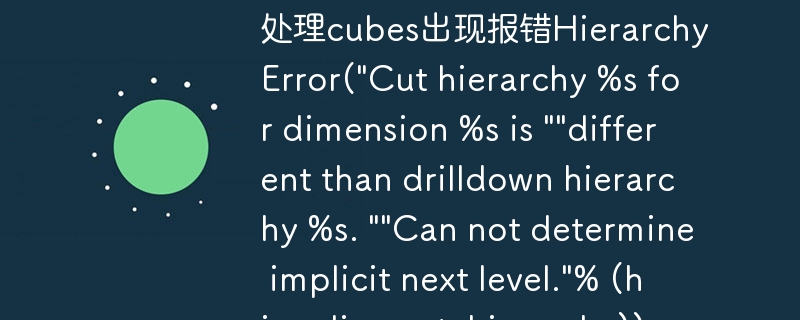 Backend Development
Backend Development
 Python Tutorial
Python Tutorial
 处理cubes出现报错HierarchyError(\'Cut hierarchy %s for dimension %s is \'\'different than drilldown hierarchy %s. \'\'Can not determine implicit next level.\'% (hier, dim, cut_
处理cubes出现报错HierarchyError(\'Cut hierarchy %s for dimension %s is \'\'different than drilldown hierarchy %s. \'\'Can not determine implicit next level.\'% (hier, dim, cut_
处理cubes出现报错HierarchyError(\'Cut hierarchy %s for dimension %s is \'\'different than drilldown hierarchy %s. \'\'Can not determine implicit next level.\'% (hier, dim, cut_

The reason for the error
This error message indicates that when using the cubes library, the drilling level in the dimension is inconsistent with the sectioning level, so the next step cannot be determined. Implicit hierarchy of levels.
How to solve
To solve this problem, you should check whether the drill level and section level when using the cubes library are consistent. You may need to modify the drill level or slice level in your code, or add more information to determine the next implicit level. If you're not sure how to do this, consult the library's documentation or community discussions.
Usage Example
The following is an example showing how to use the cubes library for drilling and sectioning. In this example, we have a "sales" cube with a "date" dimension and a "product" dimension.
from cubes import Workspace
# Create a workspace
workspace = Workspace()
# ReGISter the "sales" cube
workspace.register_cube("sales")
# Create a new browser
browser = workspace.browser("sales")
# Drill down on the "date" dimension
browser.drilldown("date", ["year", "month"])
# Cut on the "product" dimension
browser.cut("product", "product_name", "Product A")
# PerfORM the query
result = browser.aggregate()
If in this example, the drilling level and the sectioning level on the dimension "date" are inconsistent, such as:
browser.drilldown("date", ["year"])
browser.cut("date", "month", "January")
Then you will get the above error message. Because the drill level is "year" and the slice level is "month". If you need to slice the data of a certain month, you need to drill down to the month level first.
The above is the detailed content of 处理cubes出现报错HierarchyError(\'Cut hierarchy %s for dimension %s is \'\'different than drilldown hierarchy %s. \'\'Can not determine implicit next level.\'% (hier, dim, cut_. For more information, please follow other related articles on the PHP Chinese website!

Hot AI Tools

Undresser.AI Undress
AI-powered app for creating realistic nude photos

AI Clothes Remover
Online AI tool for removing clothes from photos.

Undress AI Tool
Undress images for free

Clothoff.io
AI clothes remover

Video Face Swap
Swap faces in any video effortlessly with our completely free AI face swap tool!

Hot Article

Hot Tools

Notepad++7.3.1
Easy-to-use and free code editor

SublimeText3 Chinese version
Chinese version, very easy to use

Zend Studio 13.0.1
Powerful PHP integrated development environment

Dreamweaver CS6
Visual web development tools

SublimeText3 Mac version
God-level code editing software (SublimeText3)

Hot Topics
 1386
1386
 52
52
 How to solve the permissions problem encountered when viewing Python version in Linux terminal?
Apr 01, 2025 pm 05:09 PM
How to solve the permissions problem encountered when viewing Python version in Linux terminal?
Apr 01, 2025 pm 05:09 PM
Solution to permission issues when viewing Python version in Linux terminal When you try to view Python version in Linux terminal, enter python...
 How to efficiently copy the entire column of one DataFrame into another DataFrame with different structures in Python?
Apr 01, 2025 pm 11:15 PM
How to efficiently copy the entire column of one DataFrame into another DataFrame with different structures in Python?
Apr 01, 2025 pm 11:15 PM
When using Python's pandas library, how to copy whole columns between two DataFrames with different structures is a common problem. Suppose we have two Dats...
 How to teach computer novice programming basics in project and problem-driven methods within 10 hours?
Apr 02, 2025 am 07:18 AM
How to teach computer novice programming basics in project and problem-driven methods within 10 hours?
Apr 02, 2025 am 07:18 AM
How to teach computer novice programming basics within 10 hours? If you only have 10 hours to teach computer novice some programming knowledge, what would you choose to teach...
 How to avoid being detected by the browser when using Fiddler Everywhere for man-in-the-middle reading?
Apr 02, 2025 am 07:15 AM
How to avoid being detected by the browser when using Fiddler Everywhere for man-in-the-middle reading?
Apr 02, 2025 am 07:15 AM
How to avoid being detected when using FiddlerEverywhere for man-in-the-middle readings When you use FiddlerEverywhere...
 What are regular expressions?
Mar 20, 2025 pm 06:25 PM
What are regular expressions?
Mar 20, 2025 pm 06:25 PM
Regular expressions are powerful tools for pattern matching and text manipulation in programming, enhancing efficiency in text processing across various applications.
 How does Uvicorn continuously listen for HTTP requests without serving_forever()?
Apr 01, 2025 pm 10:51 PM
How does Uvicorn continuously listen for HTTP requests without serving_forever()?
Apr 01, 2025 pm 10:51 PM
How does Uvicorn continuously listen for HTTP requests? Uvicorn is a lightweight web server based on ASGI. One of its core functions is to listen for HTTP requests and proceed...
 What are some popular Python libraries and their uses?
Mar 21, 2025 pm 06:46 PM
What are some popular Python libraries and their uses?
Mar 21, 2025 pm 06:46 PM
The article discusses popular Python libraries like NumPy, Pandas, Matplotlib, Scikit-learn, TensorFlow, Django, Flask, and Requests, detailing their uses in scientific computing, data analysis, visualization, machine learning, web development, and H
 How to dynamically create an object through a string and call its methods in Python?
Apr 01, 2025 pm 11:18 PM
How to dynamically create an object through a string and call its methods in Python?
Apr 01, 2025 pm 11:18 PM
In Python, how to dynamically create an object through a string and call its methods? This is a common programming requirement, especially if it needs to be configured or run...



